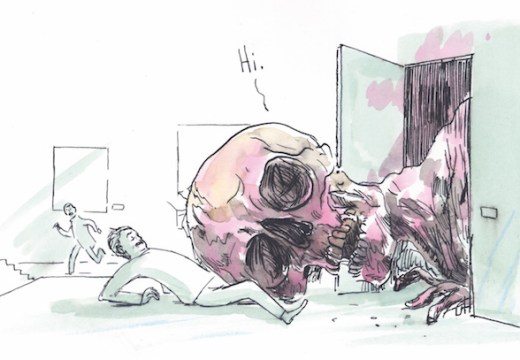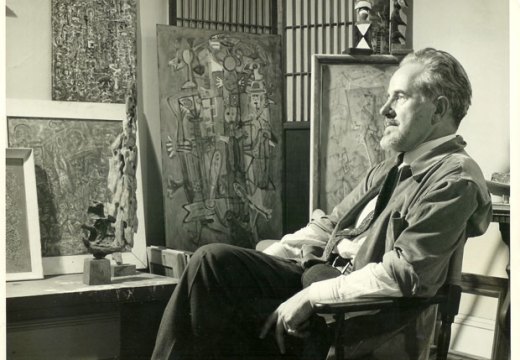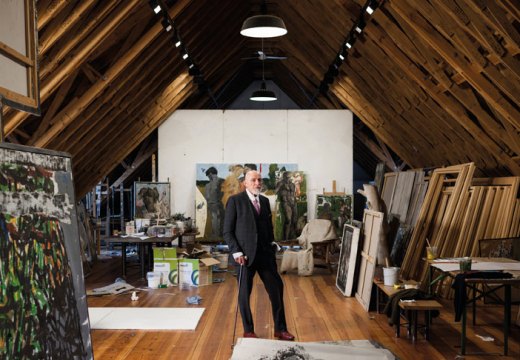The paintings in Nairobi-born Michael Armitage’s solo show ‘Peace Coma’ are executed in oil on Lubugo, a barkcloth originating from Uganda. Richly uneven, the cloths feature incidental holes, and long, vine-like stitches where two pieces of the material have been brought together. ‘I liked the way that the surface would interrupt the paintings,’ the artist remarks of his early dealings with the cloth as we view the show just before its opening. ‘It began to be a sort of metaphor of subversion.’
‘Peace coma’, a term coined to describe the emollient political aftermath of recent Kenyan elections, is an apt title for this exhibition of paintings, which are enchanting and disturbing in equal measure. Large-scale and oneiric, they feature beguiling human and animal figures, as well as hybrids of the two: there’s a baboon wearing a bikini (Leopard Print Seducer; 2016); a man with a monkey’s face emerging from his own (Slight of Hand; 2016); and a naked male figure with a tyre around his neck, caught like some mythical creature mid-metamorphosis (Necklacing; 2016). Armitage’s sources are various, with references ranging from the terrorist attack on the Westgate Mall in Nairobi in 2013 to the ostracising of female Baikoko dancers in Tanzania, and various episodes from his personal experience. The work is replete with echoes of both western art history and local symbolism.
Each work is charged with unsettling ambiguity. The comically tranquil expression of the figure in Necklacing, for example, speaks to the work’s origin in a childhood memory of a man running with a tyre around his neck, pursued by a gang bearing a lit torch. Armitage did not fully understand the scene at the time: it was only years later that he realised the man was about to be set alight for some misdemeanour. ‘I started thinking about [Goya] and his use of caricature, and wanted something about [this figure’s] expression to be a bit comic and a bit disarming,’ Armitage recalls, ‘which was a bit more true to my memory of the event.’ Strange Fruit (2016), named after the song written by Abel Meeropol in protest of American lynchings, depicts a tree seen from the vantage point of someone daydreaming beneath. Seduced, the eye travels up the tree’s lush serpentine form, only to be met by a pair of feet dangling from an upper branch. Here, the disturbing image is imagined rather than remembered, but based on stories Armitage heard of witch-hunts perpetrated by the younger members of Kenyan families against their elders.
Elsewhere in the exhibition, #mydressmychoice (2015) can be traced to a video circulated on social media in 2014, which recorded a woman being stripped and assaulted at a Nairobi bus station for wearing a miniskirt. The artist was struck by how the woman, in the footage, seemed to fall in and out of the pose of Velázquez’s Rokeby Venus. At first glance, Armitage’s painting is as captivating as the Old Master’s. A nude reclines in the centre of the composition, surrounded by gorgeous swirls of paint – but closer inspection reveals a row of men’s feet massed ominously across the top of the work. A pair of bush babies sits in the lower right of the painting, their goggle-eyed gazes not quite implicating the viewer in the abjection of this faceless female, but not quite letting them off the hook either.
Western art history is a constant, complicating presence in the show. Gauguin’s The Vision after the Sermon (Jacob Wrestling with the Angel) (1888), for example, is mirrored in the composition of Nasema Nawe (2016), a work dealing with the highly sexual Baikoko dance, which was outlawed in Tanzania in 2015. (Practised by women, traditionally in private, it featured, controversially, in a video for the song ‘Nasema Nawe’ by Bongo Flava star Diamond Platnumz.) For Armitage, Gauguin was an ‘unavoidable’ touchstone in his exploration of the exoticising gaze, and the artist is frank about wanting to understand the phenomenon as it occurs from outside of but also within a society. ‘What happens when you as a culture, or your people start to self-exoticise? What does that mean for your culture and for the practices that you have?’ Other references to western art occur, as in the breathtakingly beautiful Baikoko at the Mouth of the Mwachema River (2016), which features pink-clad Baikoko dancers reminiscent of Goya’s hovering sorceresses in Atropos (1819–23). They are positioned with their backs to the viewer, but a subtle and seemingly accidental cluster of holes in the cloth suggests a face staring back out.

Baikoko at the mouth of the Mwachema River (2016), Michael Armitage. © Michael Armitage. Photo © White Cube (Ben Westoby)
His paintings may be beguiling, but Armitage’s eye is cool and unsparing, keenly aware of the threat of a self-exoticising viewpoint. He invokes the titans of western painting from Gauguin to Goya to Picasso, but his works neither insist nor depend on the comparison. ‘I’ve never had the weight of feeling like western art history is my own,’ he muses. ‘I always feel like I’m looking in.’ Similarly, while an understanding of Armitage’s sources certainly enriches one’s reading of his work, the artist’s fluid execution means the paintings drift away from narrow political or artistic interpretations. Instead, they seem to waver in an indeterminate realm, like a stopped frame from a video or a particularly vivid moment in a dream.
‘Michael Armitage: Peace Coma’ is at Turner Contemporary, Margate, until 24 September 2017.
Unlimited access from just $16 every 3 months
Subscribe to get unlimited and exclusive access to the top art stories, interviews and exhibition reviews.

















![Masterpiece [Re]discovery 2022. Photo: Ben Fisher Photography, courtesy of Masterpiece London](http://www.apollo-magazine.com/wp-content/uploads/2022/07/MPL2022_4263.jpg)
It’s time for the government of London to return to its rightful home